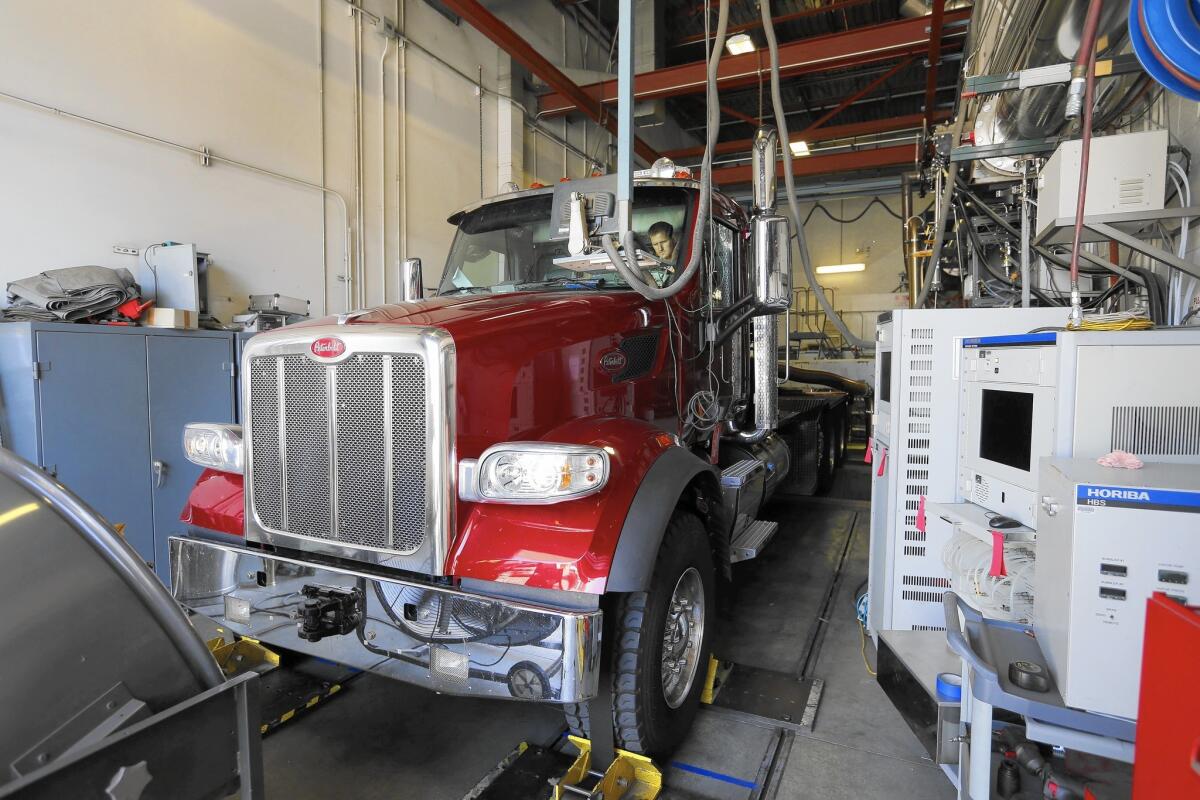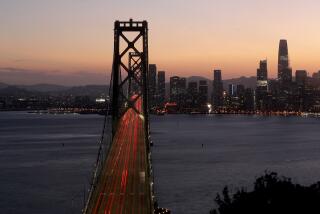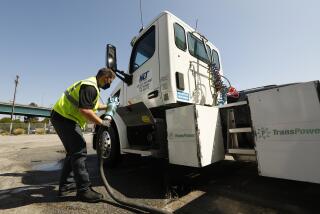Cutting ozone will require radical transformation of California’s trucking industry

At a laboratory in downtown Los Angeles, a big rig spins its wheels on massive rollers as a metal tube funnels its exhaust into an array of air quality sensors. Engineers track the roaring truck’s emissions from a bank of computer screens.
The brand-new diesel truck is among the cleanest on the road, the engineers at the California Air Resources Board testing lab say. Even so, its 550-horsepower engine spews out more than 20 times the smog-forming nitrogen oxides of a typical gasoline-powered car — and that won’t be good enough for the state to meet stricter federal smog limits adopted this month.
Cutting ozone, the lung-damaging gas in smog, to federal health standards while meeting state targets to cut greenhouse gas emissions will require a radical transformation of California’s transportation sector over the next two decades, air quality officials and experts say.
Millions of new electric cars must replace gasoline-powered models. Buses will have to run on hydrogen fuel cells. New technologies and cleaner fuels need to proliferate quickly to slash pollution from trucks, cargo ships and trains.
“We have to go to zero tailpipe emissions,” said Mark Z. Jacobson, a professor of civil and environmental engineering at Stanford University. “There’s really no other solution.”
The changes will fall heavily on vehicles because they are the dominant source of air pollution in California. The largest reductions must come from the heavy-duty sector that transports goods through ports, freeways, rail yards and warehouses. The diesel-powered freight system emits 45% of the smog-forming pollution in the state and lags behind passenger vehicles, which have reduced tailpipe emissions dramatically over 50 years of smog-fighting regulations.
The transition is beginning with automobiles. A 2012 Air Resources Board mandate aims to put 1.4 million zero-emissions vehicles on the road by 2025 and requires them to account for one in seven new car sales by that year. In one scenario under consideration by the agency, the number of electric, plug-in hybrid and fuel-cell vehicles would increase to 5 million and 40% of new car sales by 2030.
About 160,000 zero-emissions vehicles are on the road today in California — just 0.5% of the passenger fleet.
To reach air quality and climate change targets, technology being pioneered in cars must eventually be scaled up to trucks and other heavy-duty vehicles.
In July, Gov. Jerry Brown issued an executive order directing state agencies to establish “clear targets” to transition California’s freight system to “zero-emission technologies.”
That won’t be easy, state regulators say. But one advantage for California is that it can lean on many of the same efforts needed to meet its goal of cutting greenhouse gas emissions 40% below 1990 levels by 2030. Those carbon-cutting policies should simultaneously reduce levels of ozone, fine-particle pollution and cancer-causing diesel soot.
Some of those measures are outlined in a recent Air Resources Board report that projects California can reduce transportation-related pollution to meet air quality and climate change targets over the next 15 years with cleaner fuels, vehicles and energy sources. For heavy-duty vehicles, diesel engines will continue to dominate through 2030, the report says, but under even tougher emissions rules.
“While today’s trucks are significantly cleaner than their predecessors, we’ll need new engine standards that are about 90% cleaner,” said Karen Magliano, chief of the air quality planning and science division at the Air Resources Board.
Chris Shimoda, policy director for the California Trucking Assn., acknowledged the industry “is way behind light-duty cars in terms of the introduction of zero-emissions technology.”
That’s in part because the because the state Air Resources Board has not yet adopted zero-emissions requirements for freight, Shimoda said. But heavy-duty trucks also face higher technological hurdles and “the engineering challenges of trying to get a battery-electric or hydrogen fuel cell truck that can haul 80,000 pounds across the country.”
“It’s going to take time to introduce that technology,” Shimoda said.
A key driver of the changes is the nation’s worst ozone pollution in Southern California, which can reach over 100 parts per billion in inland valleys. Ozone, linked to asthma, heart disease and premature deaths, is formed when pollution from motor vehicles, power plants and other combustion sources cooks in the heat and sunlight.
Though air quality has improved markedly in California, the smoggiest regions — the South Coast basin and the San Joaquin Valley — have so far failed to meet a series of federal ozone standards going back to 1979.
Regional air quality regulators say they must cut smog-forming nitrogen oxides at least 75% beyond existing regulations to meet a 2037 deadline to clean the air to the new federal ozone limit of 70 parts per billion.
Environmentalists say Southern California officials are not acting quickly enough.
The obstacles are so great that air regulators and transportation planners “have to get a lot more aggressive,” said Adrian Martinez, an attorney for the environmental nonprofit Earthjustice.
Martinez wants to see zero-emissions lanes on freeways and electrified corridors for trucks hauling cargo in and out of the ports. “We need to get this stuff going now because these projects take decades,” he said.
Barry Wallerstein, executive officer of the South Coast Air Quality Management District, is optimistic that the region can meet ozone standards through improvements in diesel engines and new technology, such as hybrid trucks powered by overhead catenary wires.
“We shouldn’t underestimate ingenuity and ability to continue to further reduce emissions,” Wallerstein said. When pressed on the Southland’s failure to meet previous air quality standards, he said, “we need to pick up the pace.”
Wringing enough pollution out of trucks and other cargo-moving vehicles to get Southern California’s ozone levels down to 70 ppb will require a “paradigm shift” to battery-electric and fuel cell technology, said Scott Samuelsen, an engineering professor who directs the Advanced Power and Energy Program at UC Irvine. The key question, he said, “is how to make an economically viable transition of a freight industry that’s evolved with diesel engines.”
Some of those changes can be seen at the Port of Long Beach, where crews have finished building the first half of a $1.5-billion terminal that unloads, stacks and sorts shipping containers using electric cranes and driverless, battery-powered vehicles instead of diesel-burning yard tractors.
“We’re looking to expand use of electricity,” said Art Wong, a spokesman for the port. “This terminal is going to be the first.”
Back in downtown L.A., where the Air Resources Board is testing heavy-duty trucks, lab manager Keshav Sahay put the difficult task ahead in simple terms: “We have to do more.”
Twitter: @tonybarboza







